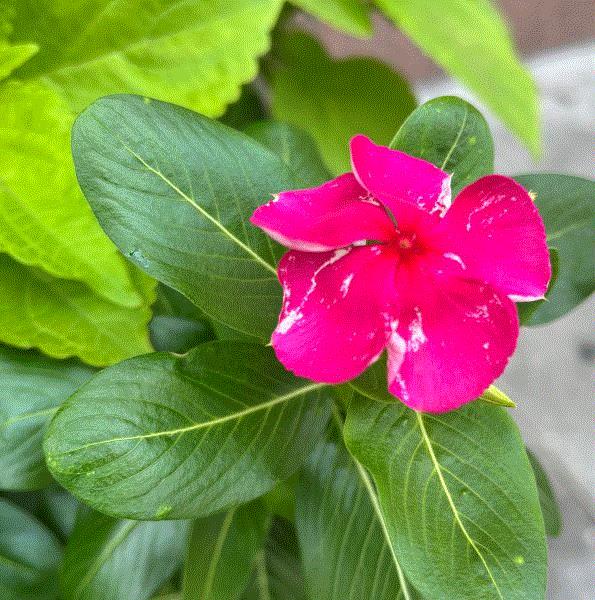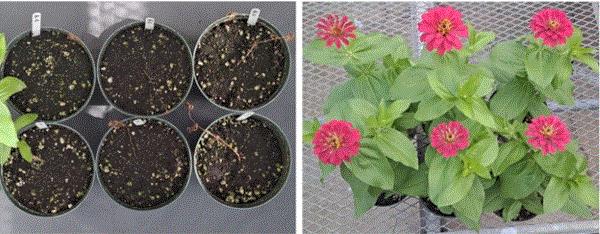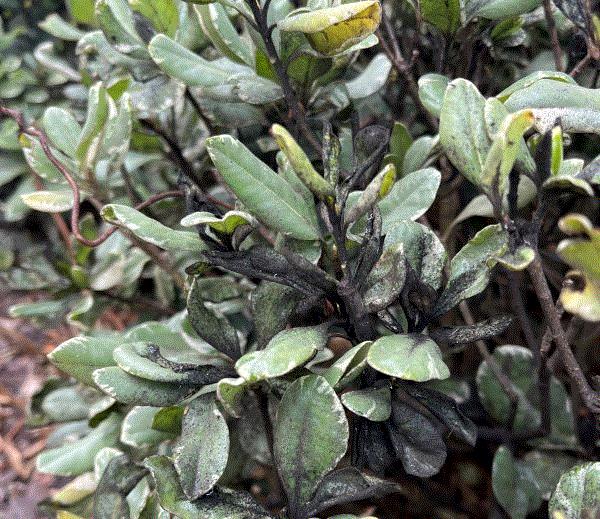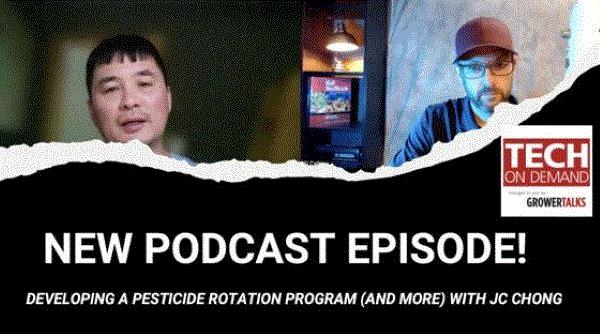Thrips, thrips everywhere!
I can now call myself a true road warrior. I’d been on the road visiting folks in California, Georgia, Louisiana and Tennessee during the past four weeks, with Cultivate punctuating the trips. I’m surprised my wife’s dog still recognized me when I got home.
Can’t say I don’t deserve this. After all, having more time to travel to help growers, distributors and clients throughout the country was an explicit goal when I decided to join SePRO.
Folks are dealing with lots of pest and disease problems, but everyone everywhere is dealing with thrips. Not just the hot new thrips on the block (Thrips parvispinus) but also the good ole western flower thrips and echinothrips (also known as the poinsettia thrips).
One of the most frustrating aspects of thrips management is the magical ability of thrips to invade a greenhouse or nursery from the surrounding fields. Screening entryways can reduce invasion, but I understand the difficulty of maintaining good airflow when using netting with mesh fine enough to stop thrips. When stopping invasion isn’t possible, the alternative may be to pay close attention to what’s going on in the fields around your operation. Is your neighbor cutting hay, harvesting wheat or defoliating cotton? If so, you may want to watch for thrips coming into the greenhouse (by setting up sticky traps and checking plants regularly) and get ready for them.

One way to get ready for the invasion is to use biological control agents. There are lots of predatory mite and bug species available. I think the key to success is to have the biological control agents released regularly even when thrips aren’t there. These biological control agents are like a standing army that’s ever ready to fight off any invading thrips population.
If thrips come into your operation mainly through cuttings, liners or plugs, dipping these incoming plant materials in a solution of biopesticide, such as Beauveria bassiana, or horticultural oil (0.1%) is an effective way of reducing the initial population of thrips. This will give you a bit more low-thrips time when biological control agents can do their jobs of suppressing the thrips population and preventing damage.
Trying to prevent damage to flowers from invading thrips has been challenging. In my trials, I have decent success in preventing damage or stippling to the leaves by drenching with a systemic insecticide (such as a neonicotinoid or a diamide). But the same approach didn’t provide sufficient protection to flowers.
As much as we hate to spray, we may have to do that to protect flowers from thrips damage. I found these products are more effective in my trials (selected trade name in the United States and IRAC number in parentheses): abamectin + bifenthrin (Avid + Talstar; 6 + 3A), acetamiprid (Tristar; 4A), chlorfenapyr (Pylon; 13), cyantraniliprole (Mainspring; 28), cyclaniliprole + flonicamid (Pradia; 28 + 29), flonicamid (29), pyridalyl (Overture; UC), spinosad (Conserve; still works in my area; 5), spinetoram + sulfoxaflor (XXpire; 5 + 4C), and tolfenpyrad (Hachi-Hachi SC; 21A).
It’s important to recognize that these insecticides only protect flower surfaces that are open at the time of the application. If you have new flowers, you’ll have to make another application to protect these newly opened flowers. So, yes, unfortunately, you’ll be looking at multiple sprays. Please rotate among different modes of action when multiple applications are made sequentially.
I did a presentation on thrips management some time ago. Want to see a recording of my presentation on thrips management? Read on!

AFE releases thrips and botrytis library
The American Floral Endowment (AFE) has made a generous act by releasing its Thrips and Botrytis Research Library. AFE has invested in research and education to combat two of the most important pest issues in floriculture—thrips and botrytis—through a special campaign since 2017. AFE is able to fund more than fifteen multi-year research projects to develop new and improved ways of controlling thrips and botrytis. My research program at Clemson University was a beneficiary of this campaign.
Instead of keeping the resources to its members and donors, AFE launched the online resource library, free for all. You can now access the library by clicking HERE.

You’ll find in the library a collection of webinars, factsheets and articles produced as tangible outcomes from the funded research projects. You’ll learn how to use foliar spray of calcium to control botrytis, and how to use biological control, ultra-violet light and insecticide rotation to better manage thrips. My recorded presentation on how to control thrips with insecticides is deposited in this library. These resources are available in both English and Spanish. This is a one-stop-shop for state-of-the-art information on thrips and botrytis management.
AFE’s efforts don’t stop at thrips and botrytis. For the past 60-plus years, AFE has provided millions in funding to support research projects on various pest management, breeding, production and economic topics, as well as myriads of issues and challenges faced by the floricultural industry. Of course, all of these aren’t possible without the generous support from the floricultural industry and AFE’s sponsors. See a list of recently funded projects by clicking HERE. Learn more about AFE and how to support AFE’s research and education efforts by clicking HERE.

ASD vs. soilborne diseases
One of the research projects supported by AFE investigated the value of anaerobic soil disinfestation, or ASD, in preventing or reducing soilborne diseases in floral crops. Francesca Hand of The Ohio State University published a short summary on the results of her AFE and Association of Specialty Cut Flower Growers-funded study on the AFE website.
Click HERE to get a copy of the summary.
What is ASD? ASD is a pre-plant soil treatment that has shown promise as a non-chemical alternative to fungicides and fumigants in reducing soilborne disease and weed severity. You’ll need a decomposable carbon source, water and tarp to perform ASD. First, you incorporate a carbon source into the soil. Then, you saturate the soil with water and tarp the soil to cut off oxygen supply to the soil for several weeks. When oxygen is depleted, anaerobic microorganisms take over and either compete with the pathogens or generate toxic compounds that can kill the pathogens. ASD reduces the survival of pathogens and weed seeds.
ASD has been tested in greenhouse- and field-grown vegetables and strawberries. It’s now being tested in floricultural crops. It’s important to know that the effectiveness of ASD varies among climates, soil types, carbon sources and pathogens or weeds. The goal of Francesca’s study was to evaluate different carbon sources (wheat bran, tomato pomace or soybean meal) in their abilities to suppress rhizoctonia in zinnia and phytophthora in gerbera daisy in ASD programs. The substrates were inoculated with pathogens, incorporated with one of the three carbon sources, and incubated at 77F over four weeks. After that, zinnia and gerbera daisy were transplanted and grown for five weeks.

Severity of rhizoctonia observed in zinnia plants grown in untreated (left) or ASD-treated (right) media. (Photo credit: Francesca Hand, The Ohio State University)
What did Francesca find? The severity of rhizoctonia steam rot was lower when zinnia plants were grown in wheat bran or tomato pomace-incorporated substrates. Phytophthora crown rot, on the other hand, was present in gerbera daisy regardless of whether the substrate was untreated or treated by ASD (all carbon sources). An additional experiment also showed that the initial amount of pathogen inoculum also played an important role in determining the efficacy of ASD.

Pittosporum psyllid
Thanks to y’all who responded to the piece on boxwood psyllid in the last issue of this newsletter. There seems to be a consensus about boxwood psyllid infestation—Meh, just prune the distorted terminals off. It won’t hurt anything. I agree with that management approach.
I often see a related species, the pittosporum psyllid, along the coast in South Carolina. I couldn’t find a pittosporum hedge on Edisto Beach that’s not showing signs of prior infestation. Like the boxwood psyllid, the pittosporum psyllid also causes distortions on terminals and produces a large amount of white wax, honeydew and sooty mold on pittosporum.
I thought I wouldn’t be seeing the pittosporum psyllid until next spring. The adults are gone, and the eggs haven’t hatched yet or the nymphs are too small to see at this time. What do you know! I saw them in Santa Maria, California, this past week.

Pittosporum psyllid only feeds on pittosporum and is native to East Asia. The first detection in California was made in 2007 on a nursery shipment of pittosporum. This population I saw seemed a little delayed in life cycle than the population in South Carolina, perhaps because of the cooler temperatures on the California Central Coast. (Highs in the 70s? What?!)
Pittosporum psyllid can cause quite a bit of distortion and sooty mold, much more than boxwood psyllid. So, many landscape care professionals in South Carolina treat the infested shrubs or hedges. I haven’t seen any infestation in commercial nurseries. A spring or early summer drench of a systemic insecticide (mainly neonicotinoids) is all it takes to reduce the population to a tolerable level. Additional foliar sprays are also done by some but there is no research data to suggest which insecticide may be the most effective.
Click HERE for a factsheet on the pittosporum psyllid.

JC did a podcast
The last piece of news this week is also a shameless self-promotion.
I recorded a podcast on insecticide rotation (and more) with Bill Calkins soon after Cultivate. The podcast is now available. Bill had a short write-up on the podcast in the last issue of his Tech On Demand newsletter.

It was fun recording the podcast; Bill and I just chatted. We talked about the why and how of developing a pesticide rotation program, with examples to illustrate some points. We also talked about how to customize rotation programs for the specific conditions and constraints in your operation. And we talked about Thrips parvispinus, which is a major concern for many growers in Florida and across the country. I talked about a rotation guide I’d developed and made some predictions as to what I think will happen with this invasive thrips species in the fall; pretty exciting and I hope I’m on the money.
Go directly to the podcast by clicking HERE. Make sure you visit Bill’s newsletter as well, because he had posted a couple of resources I shared during the podcast—one will give you a free insecticide poster and the other will link to a rotation guide I’d developed for Thrips parvispinus.




See y’all later!

JC Chong
Technical Development Manager at SePRO
Adjunct Professor at Clemson University
This e-mail received by 27,847 subscribers like you!
If you're interested in advertising on PestTalks contact Kim Brown ASAP!